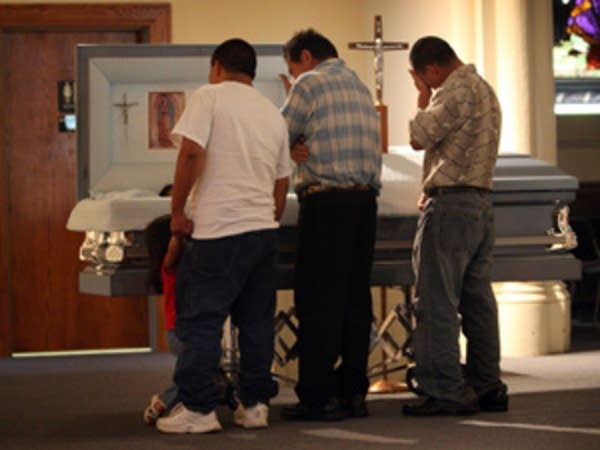Slow going in search for the missing
Go Deeper.
Create an account or log in to save stories.
Like this?
Thanks for liking this story! We have added it to a list of your favorite stories.

(AP) Divers spent a third fruitless day searching for victims of a deadly bridge collapse, finding no bodies inside a crushed car pulled earlier Saturday from the murky Mississippi River waters.
Authorities said they had been unable to check at least one other car lying beneath another vehicle on the river bottom. They planned to return to work Sunday with sonar equipment to scan areas upriver and downriver.
An examination of a car lifted onto a barge Saturday "did not find anything in the vehicle in terms of victims or human remains," said Hennepin County Sheriff Rich Stanek.

The number of dead officially stands at five, and at least eight victims are believed trapped in the wreckage.
Turn Up Your Support
MPR News helps you turn down the noise and build shared understanding. Turn up your support for this public resource and keep trusted journalism accessible to all.
A detailed examination of the wreckage around the southern end of the bridge led investigators to conclude "that is probably not where the event began," said Mark Rosenker, chairman of the National Transportation Safety Board. The southern end shifted 81 feet during the collapse.
As a result, he said, investigators will use a helicopter mounted with a high-resolution camera - equipment like that used by Hollywood film crews - to look for points where the metal was cut, sheared or pulled on the northern end.
Rosenker also announced that the FBI had completed mapping the debris field, which will allow the state transportation department to begin removing cars from the fallen bridge's deck, as well as the deck itself.

Under police escort, families of the missing were bused Saturday from a Red Cross center to the disaster site. When the doors opened, about 40 people streamed out and went straight to the edge, a few with arms wrapped around each other's shoulders.
Most appeared silent, while a few pointed at the collapsed bridge. After no more than 10 minutes, they reboarded the buses, some hugging as they left to return to the temporary Red Cross center.
The missing include Christine Sacorafas, 45, a recent transplant to Minnesota who was on her way to teach a Greek folk dancing class; Greg Jolstad, 45, a construction worker who was operating a skid loader on the bridge; Peter Hausmann, 47, a former missionary heading to pick up a friend; and Somali immigrant Sadiya Sahal, 23, a pregnant nursing student traveling with her 2-year-old daughter, Hanah.
Of the roughly 100 injured, 24 remained hospitalized Saturday, five in critical condition.
President Bush took an aerial tour of the damage Saturday morning, then went to the scene to speak with a construction worker who helped rescue children. After walking around the site, Bush went to a makeshift command post where he spoke with the families of two victims, as well as first responders and rescue workers.
Bush praised the divers and all those who rushed to help victims of Wednesday's collapse of the Interstate 35W bridge, a major Twin Cities artery.
The president also pledged to help expedite the bridge's reconstruction. The eight-lane bridge, which came tumbling within seconds during evening rush hour, once carried 141,000 vehicles a day.
State transportation officials set an ambitious timetable for rebuilding the bridge, announcing Saturday they hoped to award a contract in September and have the project completed by the end of 2008 - about 15 months.
The U.S. House late Saturday approved $250 million in funds to help repair the bridge; the Senate had approved the amount Friday. Congress still would have to appropriate the money in future legislation.
A memorial service with songs and prayers for the victims was set for 7 p.m. Sunday. Gov. Tim Pawlenty and Mayor R.T. Rybak encouraged Minnesotans to attend and honor the families and first responders.
The Minnesota Orchestra and other musicians were scheduled to perform, and any money raised will be distributed to victims' families.
Minnesota's legislative leaders began putting lawmakers on standby for a post-Labor Day special session. Pawlenty, in a huge political concession, announced he is willing to reverse his longstanding opposition to a state gas tax increase.
Pawlenty said that he hopes lawmakers will agree to his ideas for funding road and bridge repairs but that details had not yet been worked out. The state's gas tax has stood at 20 cents per gallon since 1988.
State transportation officials said Saturday that they have hired the New York-based Parsons Brinckerhoff engineering firm as the consultant to review Minnesota's bridge inspection protocols. Parsons will also assist in speedier inspections of the state's bridges.
The bridge was deemed "structurally deficient" by the federal government as far back as 1990, and inspections over the years had raised alarm, with findings of rust-eaten steel beams, missing bolts and cracks in the welding that held load-bearing parts together.
A consulting company noted that one possible fix - steel plating of fractures - carried a "relatively high cost," according to a January report. Transportation officials deny that cost pressures swayed their decisions.
State bridge engineer Dan Dorgan said he made the final decision to monitor the bridge's weaknesses through regular inspections but not take more drastic measures, such as bolstering the trusses with steel plates, which he feared could have worsened the structural problems. His staff and consultants ultimately backed that call, he said.
Repairs over the years included bolting and welding on braces, shooting concrete into cracks and patching over crumbling concrete.
After the collapse, federal officials ordered states to immediately inspect bridges of similar designs. Transportation Secretary Mary Peters said Saturday that those inspections hadn't found any immediate problems.



